Arduino Microcontroller Feature Comparison
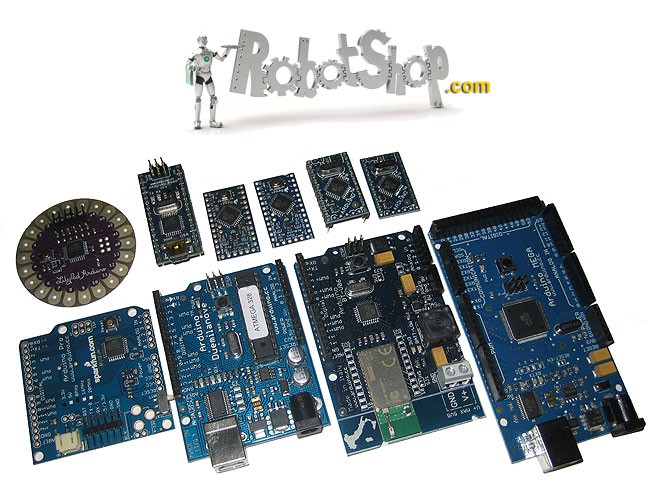
Arduino is fast becoming one of the most popular microcontrollers used in robotics.There are many different types of Arduino microcontrollers which differ not only in design and features, but also in size and processing capabilities. In this article, you’ll understand the differences between the Arduino Microcontrollers (as of 2012).
There are many features that are common to all Arduino boards, making them very versatile. All Arduino boards are based around the ATMEGA AVR series microcontrollers from ATMEL which feature both analog and digital pins. Arduino also created software which is compatible with all Arduino microcontrollers. The software, also called "Arduino", can be used to program any of the Arduino microcontrollers by selecting them from a drop-down menu. Being open source, and based around C, Arduino users are not necessarily restricted to this software, and can use a variety of other software to program the microcontrollers.
There are many additional manufacturers who use the open-source schematics provided by Arduino to make their own boards (either identical to the original, or with variations to add to the functionality). For example, the most popular board, the Diecimilla / Duemilanove (and now the Uno) has dozens of look-alike boards from other suppliers which differ slightly (different USB port, color etc) from the original.
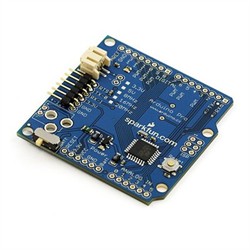
Arduino Mini / Mini Lite
The smallest Arduino product is the Arduino Mini Light which is a 24-pin microcontroller without any connectors soldered. The unit features 8 analog pins and 14 digital pins. The module is based around the ATMEGA168 processor. The only different between the Arduino Mini and the Arduino Mini Light is that the Arduino Mini has pre-soldered pin headers. The Mini lineup will be changed and will likely include the new 32U4 processor. Microcontroller ATmega328
Microcontroller ATmega328- Operating Voltage 5V
- Input Voltage 7-9 V
- Digital I/O Pins 14 (of which 6 provide PWM output)
- Analog Input Pins 8 (of which 4 are broken out onto pins)
- DC Current per I/O Pin 40 mA
- Flash Memory 32 KB (2 KB used by bootloader)
- SRAM 2 KB
- EEPROM 1KB
- Clock Speed 16 MHz
Arduino Pro Mini 3.3V / Pro Mini 5V
The Arduino Pro Mini 8MHz and 16MHz are also breadboard mountable and are a bit longer than the Arduino Mini. The Pro Mini 8MHz operates on 3.3V while the 16Mhz operates at 5V. Both feature 6 analog I/O and 14 digital I/O. The manufacturer has marked the back of the PCB to indicate which is which.- Microcontroller ATmega328

- Operating Voltage 3.3V or 5V (depending on model)
- Input Voltage 3.35 -12 V (3.3V model) or 5 - 12 V (5V model)
- Digital I/O Pins 14 (of which 6 provide PWM output)
- Analog Input Pins 6
- DC Current per I/O Pin 40 mA
- Flash Memory 16 KB (of which 2 KB used by bootloader)
- SRAM 2 KB
- EEPROM 1 KB
- Clock Speed 8 MHz (3.3V model), 16 MHz (5V model)
Arduino Nano / Nano Lite
The last breadboard mountable Arduino is the Arduino Nano. This microcontroller distinguishes itself from the others by having the USB to serial chip and connector onboard. The Nano has 8 analog pins and 14 digital pins. There are the ISCP headers to re-flash the ATMega chip. There is also the Arduino Nano Lite which does not include the downward facing pin headers.- Microcontroller Atmel ATmega328
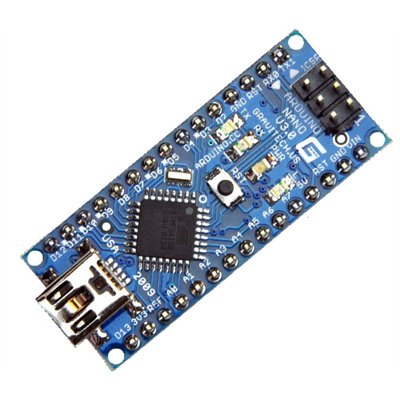
- Operating Voltage (logic level) 5 V
- Input Voltage (recommended) 7-12 V
- Input Voltage (limits) 6-20 V
- Digital I/O Pins 14 (of which 6 provide PWM output)
- Analog Input Pins 8
- DC Current per I/O Pin 40 mA
- Flash Memory 32 KB (2KB used by bootloader)
- SRAM 2 KB
- EEPROM 1 KB
Arduino Fio
The Arduino Fio is a bit of a one-off board and is essentially an Arduino Mini with a built-in LiPo charger and XBee headers. Microcontroller ATmega328P
Microcontroller ATmega328P- Operating Voltage 3.3 V
- Input Voltage 3.35-12 V
- Digital I/O Pins 14 (of which 6 provide PWM output)
- Analog Input Pins 8 (10 bit resolution)
- DC Current per I/O Pin 40 mA
- Flash Memory 32 KB (of which 2 KB used by bootloader)
- SRAM 3.3 KB
- EEPROM 1024 bytes
- Clock Speed 8 MHz
Arduino LilyPad / Simple LilyPad
Next is the Arduino Lilypad. The Lilypad stands out from all other microcontrollers because of its round, purple PCB. The lilypad was originally intended to be sewn into clothing, though enthusiasts have found many other applications for it. If you’re cautious, the Lilypad can also be washed along with the clothing. The Lilypad requires as little as 2.7V to work.- Microcontroller ATmega168V
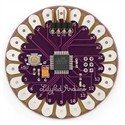 or 328V
or 328V - Operating Voltage 2.7-5.5 V
- Input Voltage 2.7-5.5 V
- Digital I/O Pins 14 (of which 6 provide PWM output)
- Analog Input Pins 6
- DC Current per I/O Pin 40 mA
- Flash Memory 16 KB (of which 2 KB used by bootloader)
- SRAM 1 KB
- EEPROM 512 bytes
- Clock Speed 8 MHz
Arduino Leonardo
The next Arduino boards have the classic Arduino board shape and can’t be mounted on breadboards. The smallest in this line is the Arduino Leonardo. The Leonardo is available with or without shield stacking headers.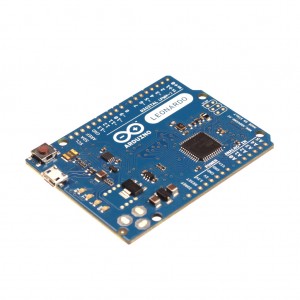 Microcontroller ATmega32U4 (onboard USB Transceiver)
Microcontroller ATmega32U4 (onboard USB Transceiver)- Operating Voltage 5 V
- Input Voltage 2.7-5.5 V
- Digital I/O Pins 14 (of which 6 provide PWM output)
- Analog Input Pins 12 (10 bit resolution)
- DC Current per I/O Pin 40 mA
- Flash Memory 32 KB (of which 2 KB used by bootloader)
- SRAM 3.3 KB
- EEPROM 1024 bytes
- Clock Speed 16 MHz
Arduino Pro 3.3V / Pro 5V
A very similar board to the Leonardo is the Arduino Pro. Some of the advantages to this board are its operating voltage range, which is 3.3 to 12V, its smaller footprint and lighter weight. The Pro doesn’t come with pin headers and although it’s smaller than other Arduino boards, it’s still compatible with Arduino shields.
- Microcontroller ATmega168
- Operating Voltage 3.3V
- Input Voltage 3.35 -12 V
- Digital I/O Pins 14 (of which 6 provide PWM output)
- Analog Input Pins 6
- DC Current per I/O Pin 40 mA
- Flash Memory 16 KB (of which 2 KB used by bootloader)
- SRAM 1 KB
- EEPROM 512 bytes
- Clock Speed 8 MHz
Arduino Diecimilla / Duemilanove / Uno
Next is the most popular of the Arduino microcontrollers; the Uno. The Uno has almost the same appearance as its predecessor, the Duemilanove, but uses an ATMega8 for USB to serial conversion. The Duemilanove was previously the Diecimilla which had a less powerful ATMega168 chip. These boards come pre-assembled and ready to use. The Duemilanove is based around the ATMEGA328 chip while the Diecimilla used the ATMEGA128.- Microcontroller ATmega168
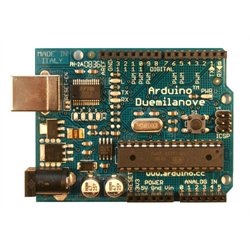 or 328
or 328 - Operating Voltage 5V
- Input Voltage (recommended) 7-12V
- Input Voltage (limits) 6-20V
- Digital I/O Pins 14 (of which 6 provide PWM output)
- Analog Input Pins 6
- DC Current per I/O Pin 40 mA
- DC Current for 3.3V Pin 50 mA
- Flash Memory 16 KB (ATmega168) or 32 KB (ATmega328)
- of which 2 KB used by bootloader
Arduino Ethernet / Ethernet PoE
The Arduino Ethernet is essentially a normal Arduino Uno where the ATMega8 chip and USB plug are changed for an Ethernet port. The PoE (power over ethernet) version means you don't need a separate power supply (wall adapter for example), although your router must also be PoE compatible. A similar setup can be done using a standard shield-compatible Arduino and an Ethernet shield. Microcontroller ATmega328
Microcontroller ATmega328- Operating Voltage 5 V
- Input Voltage 7-12 V (36 to 57V PoE)
- Digital I/O Pins 10* (of which 6 provide PWM output)
- Analog Input Pins 6 (10 bit resolution)
- DC Current per I/O Pin 40 mA
- Flash Memory 32 KB (of which 2 KB used by bootloader)
- SRAM 3.3 KB
- EEPROM 1024 bytes
- Clock Speed 16 MHz
Arduino Bluetooth
Next on the list is the Arduino Bluetooth. The layout of the board is identical to that of the Duemilanove, but with one big difference: the Arduino Bluetooth board replaces the USB plug with a Bluetooth module, meaning you program it remotely. Take note that the board has different power requirements than the Duemilanove and doesn’t have a 3.3V output pin. The 9V output pin indicated on the board is not actually functional.- Microcontroller ATmega328

- Operating Voltage 5V
- Input Voltage 1.2-5.5 V
- Digital I/O Pins 14 (of which 6 provide PWM output)
- Analog Input Pins 8 (4 are broken out onto pins)
- DC Current per I/O Pin 40 mA
- Flash Memory 16 KB (of which 2 KB used by bootloader)
- SRAM 2 KB
- EEPROM 51 KB
- Clock Speed 16 MHz
Arduino Mega 1280 / 2560
The most recent addition to the Arduino lineup is the Arduino MEGA. This board is physically larger than all the other boards and offers significantly more digital and analog pins. The MEGA uses a different processor allowing greater program size and more.- Microcontroller ATmega1280
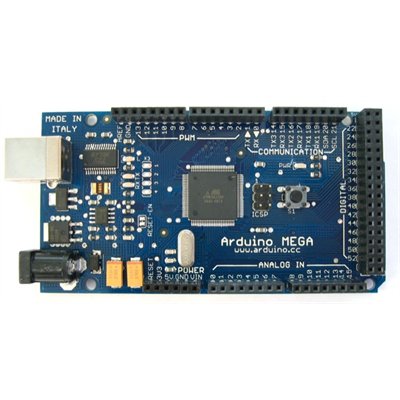 or 2560
or 2560 - Operating Voltage 5V
- Input Voltage (recommended) 7-12V
- Input Voltage (limits) 6-20V
- Digital I/O Pins 54 (of which 14 provide PWM output)
- Analog Input Pins 16
- DC Current per I/O Pin 40 mA
- DC Current for 3.3V Pin 50 mA
- Flash Memory 128 KB or 256KB
- SRAM 8 KB
- EEPROM 4 KB
- Clock Speed 16 MHz
Arduino Mega ADK
The Arduino ADK is intended to connect to Google Android based devices. Note that a cell phone will attempt to draw power from the board (often more than a USB connected to a computer can supply); an external battery or wall adapter is highly suggested. Microcontroller ATmega1280 or 2560
Microcontroller ATmega1280 or 2560- Operating Voltage 5V
- Input Voltage (recommended) 7-12V
- Input Voltage (limits) 6-20V
- Digital I/O Pins 54 (of which 14 provide PWM output)
- Analog Input Pins 16
- DC Current per I/O Pin 40 mA
- DC Current for 3.3V Pin 50 mA
- Flash Memory 128 KB or 256KB
- SRAM 8 KB
- EEPROM 4 KB
- Clock Speed 16 MHz
Thanks for helping to keep our community civil!
Notify staff privately
You flagged this as spam. Undo flag.Flag Post
It's Spam
This post is an advertisement, or vandalism. It is not useful or relevant to the current topic.
This post is an advertisement, or vandalism. It is not useful or relevant to the current topic.
You flagged this as spam. Undo flag.Flag Post



